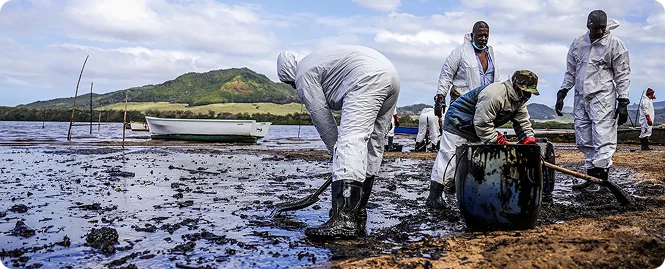Common Risks Faced by Gas Stations
Table of Contents
Key Takeaways
-
Gas stations face unique risks, including fuel spills, fire hazards, and environmental damage.
-
Liability risks for gas stations demand rigorous risk assessment and proactive safety protocols.
-
Theft and vandalism in gas stations remain critical concerns, requiring advanced security measures.
-
Cybersecurity threats and natural disasters necessitate continuous IT and emergency preparedness.
-
Proper insurance, including coverage options recommended by Insure C-Store, is essential to protect your business.
Being aware of risks that gas stations are frequently exposed to is crucial to ensuring the success and safety of your business. Gas stations work in an extremely risky environment as they constantly deal with hazardous materials, theft attempts, and evolving fuel costs. Some of the safety hazards that stations are normally exposed to are fuel spills, fire outbreaks, and equipment breakdowns. These risks put not only the business but also other customers who are nearby at risk.
Therefore, understanding the common risks allows owners to implement measures that could help minimize financial setbacks and ensure long-term success. One of the most effective ways of reducing operational hiccups and monetary losses is to be vigilant and implement quality risk management strategies. When the owner is able to identify common threats and implement safety protocols that help combat them, their business can prevent a multitude of unforeseen circumstances, like accidents, injuries, and financial fraud.
Fuel Spill and Environmental Hazards
Fuel spills at gas stations pose significant environmental hazards by contaminating soil and water sources, leading to long-lasting ecological damage. Leaks from faulty fuel pumps or storage tanks can release hazardous chemicals, endangering wildlife and human health. Incidents like the 2010 Gulf oil spill exemplify how rapid fuel leakage disrupts local ecosystems and communities. Regular maintenance and vigilant monitoring are essential to mitigate these risks effectively. These challenges demand immediate action and robust risk assessment.
Adhering to strict safety procedures and environmental regulations is crucial for preventing fuel spills and mitigating cleanup costs. For example, a local gas station in Texas implemented routine inspections and emergency protocols, significantly reducing spill incidents. By employing proper maintenance practices and leveraging gas station risk management strategies, businesses can protect their environment and avoid costly penalties. Learn more about these safety measures suggested by the EPA to ensure effective risk prevention for the station’s success.

Fire and Explosion Risks
Gas stations inherently face high fire and explosion risks due to the presence of flammable fuels and volatile chemicals. Accidental ignition from sparks, static electricity, or equipment malfunction can trigger catastrophic events. Incidents like the 2019 explosion at a gas station highlighted the significance of implementing safety measures in station premises. Understanding liability risks for gas stations is crucial to protect both property and lives, underscoring the need for comprehensive risk assessment and timely intervention.
Implementing fire prevention protocols is essential for mitigating explosion hazards at gas stations. For instance, one station in California installed security cameras and automatic shut-off systems, significantly reducing fire incidents. Regular inspections, proper equipment handling, and adherence to fire safety codes further risks. Investing in insurance and specialized coverage options can help cover the cost of damages. Additionally, providing staff training on emergency response procedures is crucial for enhancing safety and preparedness during potential incidents.

Theft and Robbery
Due to cash handling and late-night operations, gas stations are frequent targets for theft and robbery. Limited staffing and unsecured areas often invite criminal activity. The armed robbery that took place at a Shell gas station in Atlanta on January 24, 2025, highlights the urgent need for improved surveillance systems and security measures to enhance safety and prevent criminal acts. During this incident, a suspect wielded a gun and attacked a victim, causing concern within the community.
Implementing robust security measures is essential for safeguarding gas stations during off-hours, especially given the increasing rates of crime in urban areas. Upgrading lighting and installing security cameras can deter criminals effectively. For instance, a Chicago station experienced a dramatic reduction in theft incidents after adding 24-hour surveillance and motion detectors that record continuously. Regular risk assessments and staff training strengthen defenses against potential threats. Such measures minimize liability risks but also enhance overall safety.

Workplace Injuries
Workplace injuries at gas stations are a significant concern, often resulting from slips, trips, and falls. Employees handling fuel or operating heavy equipment risk serious harm without strict safety protocols. In 2019, a 26-year-old customer service representative employed at Speedway LLC endured severe injuries after slipping on ice near the back entrance of the store. This occurrence caused a fractured right tibia that required immediate surgery and various other medical treatments. This incident highlights the importance of coverages like workers' compensation.
Effective employee training and strict safety protocols are vital to reducing workplace injuries. Regular drills, proper use of protective gear, and clear emergency procedures minimize risks. For instance, after comprehensive training, a New Jersey gas station saw a significant drop in accidents and increased staff confidence. These measures protect employees while reducing insurance risks and operational disruptions. Additionally, fostering a culture of safety encourages employees to prioritize their well-being, further enhancing workplace productivity and satisfaction.

Vandalism and Property Damage
Vandalism poses a significant threat to gas stations by damaging pumps, signage, and building exteriors, leading to costly repairs and disruptions. In high-crime areas, repeated acts of graffiti, broken windows, and defacement compromise safety and business continuity. Gas station operators should invest in security measures, install surveillance cameras, and conduct regular property inspections. These proactive steps effectively reduce risk, deter criminal activity, and ensure the facility remains a safe, welcoming environment for customers and employees.
Securing the premises through enhanced lighting, security cameras, and alarm systems prevents vandalism. Regular inspections and prompt repairs help maintain facility integrity. For instance, suppose a gas station experiencing repeated vandalism decreases such incidents after upgrading its surveillance system and outdoor lighting. These actions protect assets and also deter criminal behavior. Implementing access control measures, such as a key card system and security personnel, provides a sense of safety. Community involvement also strengthens vigilance against threats.

Compliance and Regulatory Risks
Non-compliance with environmental and safety regulations can impose severe penalties on gas stations, including hefty fines and even forced shutdowns. Failure to adhere to proper protocols may result in significant liability risks for gas stations, exposing them to legal and financial challenges. A real-life incident in California revealed how a station incurred millions in fines due to regulatory oversights. This scenario emphasizes the importance of risk assessment and staff training to meet regulatory standards consistently.
Staying updated with local, state, and federal regulations is crucial for compliance and preventing operational disruptions. For instance, a gas station in Ohio took the initiative to review regulatory updates and adjust its procedures accordingly, ensuring it adhered to fuel storage and dispensing guidelines. This proactive approach significantly reduced liability risks and safeguarded the business against potential shutdowns. Managers can stay informed by utilizing industry newsletters and regulatory portals, which provide essential updates and insights.

Cybersecurity Threats
Cybersecurity threats are a growing concern for gas stations, as hackers target digital payment systems, credit cards, and customer data. Outdated software and weak security make these businesses vulnerable to cyberattacks. A nearly undetectable card skimmer found at a Southern California gas station highlights the growing cyber threat of financial fraud. This case emphasizes the importance of secure payment infrastructure, encryption, and routine cybersecurity checks to protect customers and operations of stations from data theft.
To defend against cyber threats, gas stations must implement advanced security measures such as firewalls, encryption, and employee training. A gas station in Texas successfully avoided a breach by upgrading its payment systems and adopting multifactor authentication for internal access. Regular IT audits and strict monitoring of digital transactions help detect and prevent cyber threats early. These proactive steps minimize financial losses and enhance customer trust, ensuring the security of sensitive information and business continuity.

Natural Disasters and Weather Risks
Natural disasters such as hurricanes, floods, and snowstorms can severely disrupt gas station operations, causing damage to fuel pumps, power outages, and extended closures. From September 2010 – March 2011, a series of earthquakes near Greenbrier, Arkansas, with the largest reaching a magnitude of 4.7, was linked to nearby injection wells, raising concerns about gas station safety and infrastructure stability. Such disasters result in lost revenue and infrastructure damage without proper preparation for natural events.
Preparation is crucial to minimizing weather-related disruptions. For example, a station in Louisiana reduced downtime during Hurricane Ida by installing a backup power generator and elevating equipment above flood levels. Emergency response plans, reinforced structures, and coordination with disaster response agencies improve resilience. Regular inspections of underground storage tanks and storm-resistant designs further protect the facility. Investing in preventive measures ensures gas stations can continue their business operations and recover swiftly after extreme weather events.

Employee Theft and Fraud
Internal theft and fraud are common risks at gas stations, particularly in cash handling, inventory management, and fuel dispensing. A Minnesota gas station employee was accused of stealing and cashing in $19,220 worth of lottery scratch-off tickets over three months. Such incidents highlight the importance of strict monitoring systems and employee accountability measures to prevent financial losses and maintain operational integrity.
Gas stations can deter theft and fraud through stringent security protocols, such as surveillance cameras, real-time transaction tracking, and dual-employee cash management. A station in Michigan significantly reduced cash shortages after installing point-of-sale monitoring software, which flagged unauthorized discounts and voided transactions. Routine audits and employee background checks further help identify potential risks. Implementing these preventive measures protects revenue and ensures a secure, well-regulated work environment for both employees and business owners.

Conclusion
This guide has explored nine common risks every gas station owner faces, including unique risks such as fuel spills, fire hazards, cybersecurity threats, internal fraud, and theft and vandalism in gas stations. Each risk demands proactive management, strict safety protocols, and regular assessments to mitigate liability and protect assets effectively.
Insurance is vital for gas stations to cover the cost of unforeseen events and minimize financial risks, addressing insurance risks for gas stations. Insure C-Store recommends coverage options that protect your business from property damage, liability, and operational disruptions. With proper insurance, owners can focus on growth and risk management.

